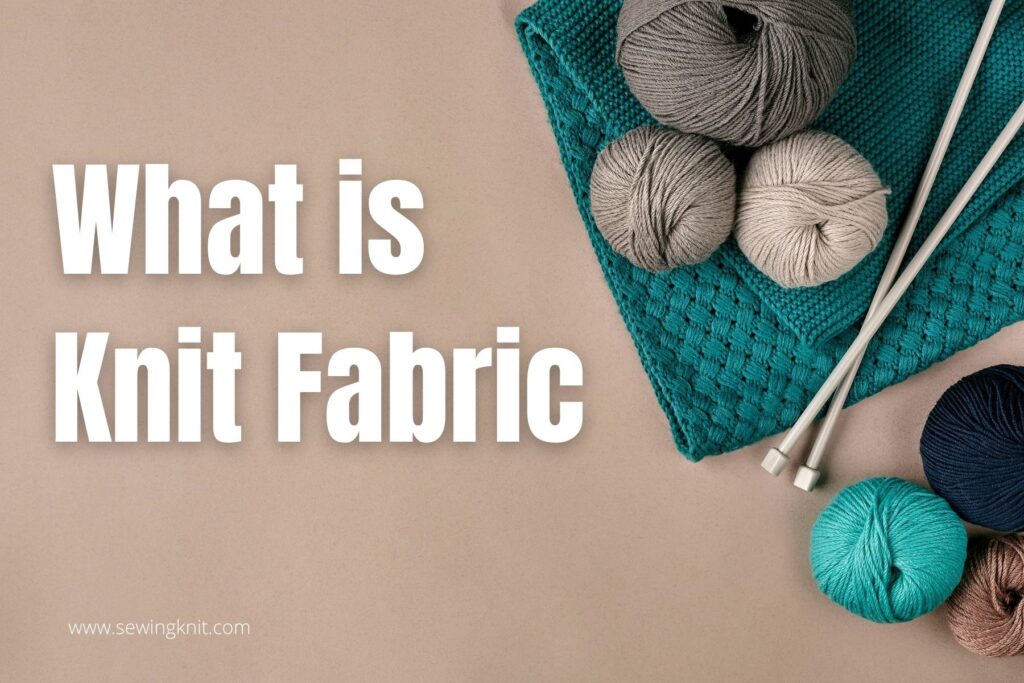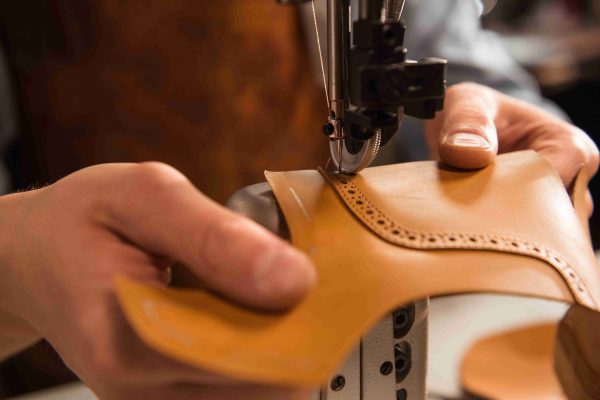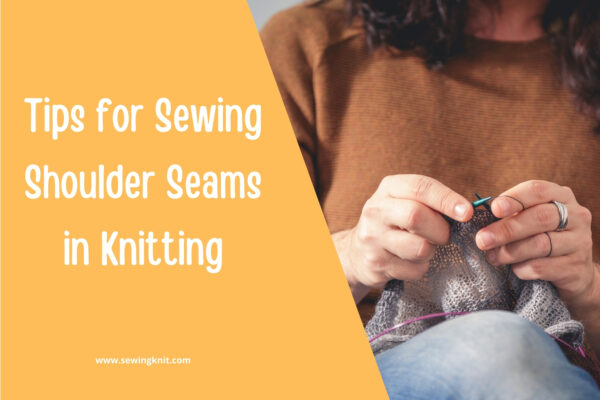
Knit fabric is constructed out of a single yarn that is twisted repeatedly to give it a twisted appearance. A piece of woven fabric is made up of several strands that intersect at right angles to produce the seam. One of the ways to tell if a cloth is knit or woven is to expand it.
Knit fabric has a framework made up of overlapping yarns looping. Since the yarn is introduced sideways to produce sets of coils, each of which is independently interlocked upward with the matching loop in the following horizontal row, this phrase is used. This is a form of knitting that may be done manually with two knitting needles and a single skein of yarn.
Knitting machinery can generate flattened or spiral fabrics depending on the kind. It can be observed that the interlocking loops create vertical rows known as wales and horizontal rows known as courses. Wales and courses meet at right angles when the material is properly on grains and therefore is the direct equal of warp and weft in terms of grain.
What does knit fabric consist of?
Knit textiles may be manufactured from a variety of fibers, including kinds of Cotton, Spandex, Silks, Wool, Viscose.
Types of Knit Fabric
Purl Knit Fabric
Purl knit Fabrics have the same appearance across both surfaces. The purl stitch may be used to make a variety of beautiful layouts and motifs. Thick and heavy jumpers and children’s clothes are frequently made using them. Purl knits are known for their sluggish manufacturing pace.
Purl knit is created by crocheting yarn in one wale of the cloth using sequential knit and purl stitches. Knit and purl stitches interchange in the fabric’s design. The fabric is convertible and looks the same on both sides. The cloth is plain and does not wrinkle. In the length direction, it is a stretcher.
Flat or Jersey Knit Fabric
Knit textiles contain prominent horizontal ribs on the rear and apparent flat vertical stripes on their front. The plain or jersey knit stitch is commonly used because it is quick, cheap, and can be modified to create elegantly textured textiles. Regular flat knits have a propensity to “run” if a yarn is split, which is a big drawback.
To produce Velour, Velvet, and Plush Textiles, the flat or jersey stitch can be modified by using various fibers or double-looped stitches of variable sizes. Nylon hosiery, traditional male undergarments, as well as t-shirts are all made with this stitching.
The most prevalent form of knit fabric is jersey. Knitting and cross stitches are combined with the same thread to create this cloth. As a result, this fabric is often referred to as single or plain knit. Due to the extremely distinct right and wrong sides of the material, this sort of knit fabric stands out from all the others.
Cardigans
Cardigans are a Rib Knit variant that comes in half or full cardigan styles. Tucked stitch designs are unique to the cloth. As a result of the elevated appearance, cardigans are made of a thicker fabric.
Cardigan in Half
The Half Cardigan is composed of a first course that is entirely knit on both thread surfaces and a second course that is entirely knit on the front needles and entirely tucked on the rear needles.
The fabric’s tucked loops limit the fabric’s stretch in the breadth axis. The fabric is not changeable. They’re usually coarsely knit and used to make sweaters and flannels.
Cardigan in Its Entirety (Full)
Repetition of one course of all knit on front needles and all tucked on back needles, followed by a second course of all tuck on front rounds and all knit on back needles, makes up the Full Cardigan.
Both sides of the Full Cardigan are identical. Tucked loops in excess make the cloth heavy and thick. It’s commonly stitched in a coarser gauge and used to make jumpers and other fashion items. Wool or acrylics are the most common materials used in cardigans.
Knit Fabric with Rib Stitch
Rib Stitch Knits feature stitching on both sides of the fabric, resulting in a column of wales on the front and rear. Rib stitch creates textiles with a lot of flexibility. Rib knits are used to create the “ribbing” seen on the lower margins of jumpers, wrist cuffs, and collars. Weaving yarns as alternative knit and purl stitches in one course of the cloth creates rib-knit fabric.
It’s a convertible fabric since it looks the same on both sides. Both plain and cyclic knitting machines can be used to make these.
Milano Ribs
Milano Ribs are a Rib Knit modification that comes in half and full Milano variants. Sew, and embroidery designs are included in the fabric.
Half Milano
Half Milano is made up of one course of the all knit from both needle beds and the second course of all stitched on only the front needles. Its construction is uneven. It’s often stitched in a coarse gauge and is commonly used to make sweaters.
Full Milano
The first course of all knit on both needle sides, and second course of all knit on the front needles alone, as well as the third course of all knit on rear needles only make up a complete Milano.
Full Milano is a beautifully woven fabric that provides more comfort. Half Milano rib has less structural integrity than full Milano rib.
Fabric with a Double Knit
Interlocking stitches and their variants are used to create double knits. Two sets of needles, placed at an inclination to each other, are used in operation. Polyester and wool are the most common materials used for double knitting.
Weft knitted textiles having two kinds of needle beds are known as double knits. The composition of the cloth is much more robust and dense. The materials do not twist or ravel at the corners. They can be designed and textured in a variety of ways. One or two yarns are needed to weave one course in the cloth.
Knit Fabric with Interlock Stitch
Interlocking pattern knits are rib stitch knits with a twist. Interlocks have the same front and reverse. Until finer yarns are utilized, these textiles are slightly greater and heavier than conventional rib-knit materials.
Threads are interlocked to avoid runs and make clothing materials that don’t ravel or curl at the borders.
Knitted Tricot Fabric
Filament yarns are now almost solely used in tricot knits since the consistent length, and good value is required for usage with ultra-high-speed tricot knitting machines. Knitted Fabrics made using a tricot knitting machine are either basic or feature a basic geometric pattern.
The fabric’s frontal surface features vertical wales that are clearly delineated, and the rear surface has diagonal courses.
Warp Knitted
Warp knitted textiles are produced with strands from the warp beam in a particular knitting machine. They are crocheted from several threads, unlike weft knits, with strands producing loops in neighboring wales. A pick glass may be used to identify the cloth. The fabric features gently sloping vertical knitting loops on the front side and slanted horizontal floats on the back.
They aren’t vulnerable to raveling. Yarn loops are produced in a vertical or warp orientation to create warp knit textiles. All of the threads needed for a warp knit breadth are put parallel to each other, identical to how yarns are positioned in weaving.
Raschel Knit Fabric
Raschel knits are made from various densities and kinds of spinning or filament yarns. Intricate patterns, the accessible aspect of yarn or lace, and an almost three-dimensional surface effect design are all hallmarks of raschel knits.
Fabric with Cable Knits
The unique looped transfer process is used to create cable fabric, which is a double knit fabric.
The fabric’s wales have a rope-like look, and plaits are made by transferring loops between neighboring wales. As the threads cross one other, the fabric creates an intriguing surface pattern that looks like strands. It’s a popular fabric for sweaters.
Knitted Fabric with a Bird’s Eye Pattern
Bird’s eye is a dual knit fabric with a tucked thread and knitting stitch pair. The tuck stitching produces an eyelet or whole impression on the cloth surface that looks like a bird’s eye.
The fabric is generally composed of a variety of colored threads that create a shuffling appearance. The cloth might be created with eyelet patterns. They’re a popular fabric for apparel, especially for formal clothing.
Knitted Pointelle Fabric
The Fabric Pointelle is a sort of dual knit. The cloth took on the appearance of lace, with holes created by the transferred stitches.
The fabric’s delicate appearance makes it perfect for female outfits, like skirts, tops, and children’s clothing.
Knit Fabric with Intarsia
Intarsia is a solid knit cloth with a design. Needlework multicolored yarns are used to make it. The fabric is made up of the same course knitted in several shades and yarns. It features multicolored graphics in the form of blocks that are spread across various color backdrops.
On both the front and back sides of the cloth, the designs are alike. On the reverse of the cloth, there are no floats. Tees, tops, and jumpers are commonly made from it.
Jacquard Knitting
Jacquard jerseys are single jersey fabric produced using a Jacquard process on Circular Knitting machines. They’re the most basic way to make variegated textiles. They’re made in a variety of designs.
Differently colored grooves composed of different threads run in the same direction on jacquard textiles. Single jersey jacquards are known for their floats. In the knitwear business, they are frequently utilized.
Knitted Terry
Knitted Terry is a stack jersey fabric comparable to woven textiles that are manufactured with a specific accessory in normal circular knitting machines.
The fabric’s surface is covered in loops. The cloth is composed of two pairs of threads, which are used to produce the pile and the other for the foundation fabric.
Knit terry seems to be more convenient than woven terry because it is gentler, stretchier, and much comfier. They are not, although, as hard or as long-lasting as woven terry. It is commonly used in swimwear, towel, and shawls due to its tenderness and absorption.
Velour Knitted Fabric
Soft projecting fibers on the metal substrate characterize Pile jersey textiles. They, too, are constructed of an extra set of yarns that create pile looping on the fabric surface, similar to knit terry.
These pile loops are chopped uniformly and coated in Velour. It may be colored and comes in a variety of neutral tones. They’re found in high-end garments, including blazers, tops, and gowns.
Knitted Silver Fabric
Stacked jersey fabric makes up the Sliver Knit. In contrast to Velour fabric, Sliver knit fabric has a wider stack on the fabric surface. It’s created with sophisticated cyclic knitting machines that connect exterior strands that seem like fur to the cloth by knitting sliver along with the base yarn that makes the fabric.
Compared to other stack jerseys, Sliver knit textiles have lengthier and thicker piles on the fabric surface. Imitation fur textiles made of animal-printed Sliver knit fabrics are quite trendy. They’re increasingly common than fur since they’re lighter, stretchier, and don’t need specific maintenance. Jackets and coats are frequently made using them.
Knitted Fleece Fabric
Weft insertion jerseys are made of fleece. Weft inclusion textiles are crocheted fabrics with an extra yarn added for each course. These extra yarns are kept in place by the loops in each cloth course rather than being knit.
Attractive or useful yarn, such as stretch yarn, can be added. It gives support, protection, and warmth. In most cases, the inserted yarn is rougher than the foundation yarn. Fleece is what happens when the inclusion yarns that make piles are ripped and napped. Linen, Cotton/Polyester, Wool, and Acrylic are the most common materials used. Coats, gowns, athletics, and jumpers are examples of end uses.
Frequently Asked Questions
What is an example of knit fabric?
Answer: Button-up shirts, pants, and denim jackets are classics. Knit fabric is made by interlacing (or knitting) one set of yarn with another set. Yoga pants, t-shirts, jumpers, and undergarments are examples.
Is there a difference between knit and cotton?
Answer: Knits are available in the same fiber composition as wovens: 100 percent cotton, 100 percent polyester, cotton/polyester blends, cotton/spandex mixes, woolen, nylon, rayon, and so on. If the pattern asks for knits, there’s a little chance you’ll be able to replace them with wovens, even if they’re stretchy.
Is knit material a good choice?
Answer: It’s ideal for sewing dresses, broad trousers, and kilts because of its fluid drape and smooth feel. Breathability, absorbency, and adaptability – it’s an all-season fabric – are just a few of the benefits of cotton knits. Cotton knit fabric, on the other hand, does not hold its shape well and is prone to stretching.
Is cotton knit or woven?
Answer: The phrases “woven” and “knit” don’t relate to specific textiles but rather to the pattern or construction of the cloth. Cotton, for example, is a fabric that is available in both knit and woven forms. Each structure may be further categorized based on the sort of structure used to put it together.
Final Words
Knits come in a wide variety of styles. Any of them will suffice for your sewing job. Finding them in the fabrics, you would like to dress up will be the secret. Because the various knits serve distinct objectives, you can use them all at varying periods. Simply select the appropriate color and do a stretch test to determine the best cloth for your project.





2 thoughts on “What is Knit Fabric?”
Comments are closed.